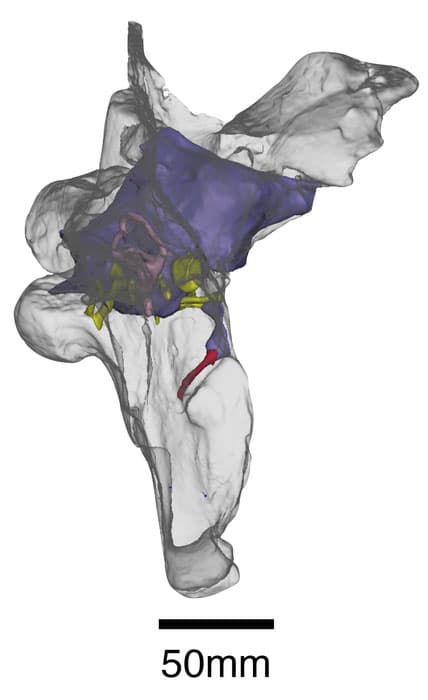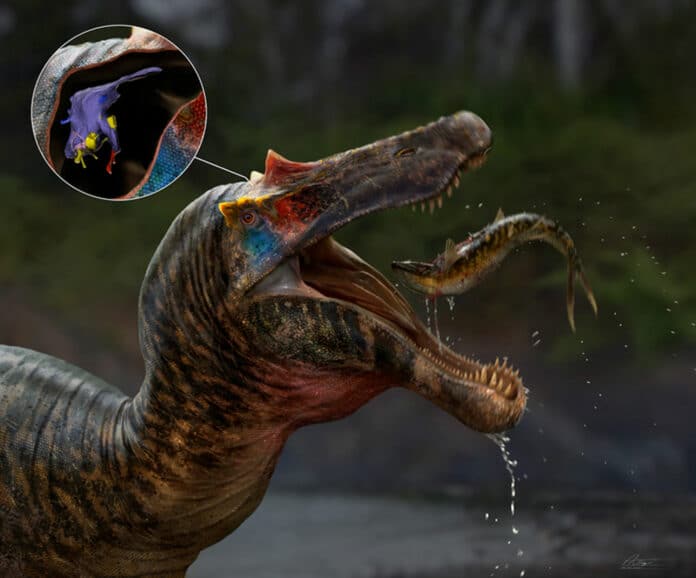Spinosauridae is an aberrant clade of long-snouted, large-bodied theropod dinosaurs with representative taxa and key specimens from the fossil records of Europe, Asia, Africa, and South America. They had long, crocodile-like jaws and conical teeth.
These adaptations helped them live a somewhat-aquatic lifestyle that involved stalking riverbanks in quest of prey, among which were large fish. This way of life was very different from that of more familiar theropods, like Allosaurus and Tyrannosaurus.
To better understand the evolution of spinosaur brains and senses, scientists from the University of Southampton and Ohio University have reconstructed the brains and inner ears of two British spinosaurs. To do so, they scanned fossils of Baryonyx from Surrey and Ceratosuchops from the Isle of Wight.
These two are the earliest spinosaurs for whom braincase material is known. Across 125 million years ago, the enormous beasts would have been sauntering around the earth. Both specimens’ braincases are in good condition, and the scientists used digital reconstruction to recreate the inside soft tissues that had long since decayed away.
The olfactory bulbs, which process smells, weren’t well developed, and the ear was likely tuned to low-frequency sounds, according to the experts. The brain regions responsible for maintaining balance and a fixed gaze on prey may have been less developed than in later, more specialized spinosaurus.

The University of Southampton Ph.D. student Chris Barker, who led the study, said, “Despite their unusual ecology, it seems the brains and senses of these early spinosaurs retained many aspects in common with other large-bodied theropods – there is no evidence that their semi-aquatic lifestyles are reflected in the way their brains are organized.”
“One interpretation of this evidence is that the theropod ancestors of spinosaurs already possessed brains and sensory adaptations suited for part-time fish catching and that ‘all’ spinosaurs needed to do to become specialized for a semi-aquatic existence was evolve an unusual snout and teeth.”
Contributing author Dr. Darren Naish said, “Because the skulls of all spinosaurs are so specialized for fish-catching, it’s surprising to see such ‘non-specialized’ brains. But the results are still significant. It’s exciting to get so much information on sensory abilities – hearing, sense of smell, balance, and so on – from British dinosaurs. Using cutting-edge technology, we obtained all the brain-related information possible from these fossils.”
Co-author Lawrence M. Witmer, professor of anatomy at the Ohio University Heritage College of Osteopathic Medicine, said, “This new research is just the latest in what amounts to a revolution in paleontology due to advances in CT-based imaging of fossils. We’re now in a position to be able to assess the cognitive and sensory capabilities of extinct animals and explore how the brain evolved in behaviourally extreme dinosaurs like spinosaurs.”

Dr. Neil Gostling, who leads the University of Southampton’s EvoPalaeoLab, said, “This new study highlights the significant role British fossils have in our constantly evolving, fast-moving understanding of dinosaurs, and shows how the UK – and the University of Southampton in particular – is at the forefront of spinosaur research. Spinosaurs themselves are one of the most controversial of all dinosaur groups, and this study is a valuable addition to ongoing discussions of their biology and evolution.”
Journal Reference:
- Chris Tijani Barker et al. Modified skulls but conservative brains? The palaeoneurology and endocranial anatomy of baryonychine dinosaurs (Theropoda: Spinosauridae). Journal of Anatomy. DOI: 10.1111/joa.13837
